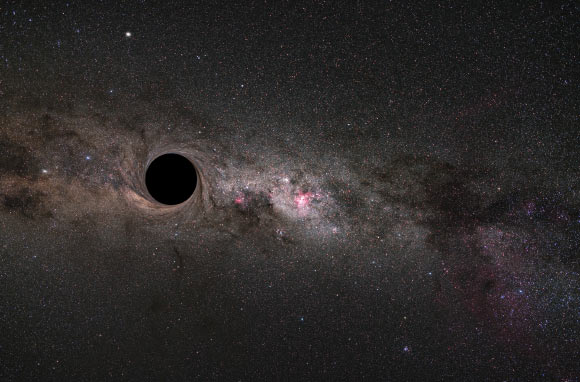
Primordial black holes are one of the strongest candidates for the Universe’s dark matter. In this scenario, their abundance would be large enough for at least one object to cross through the inner Solar System per decade. A flyby like this would introduce a wobble into Mars’ orbit, to a degree that today’s technology could actually detect, according to a team of MIT physicists.

Tran et al. argue that the abundance of asteroid-mass primordial black holes can plausibly be probed by existing and near-future data. Image credit: Sci.News / Zdeněk Bardon / ESO.
Dark matter is a hypothetical form of matter that is invisible across the entire electromagnetic spectrum yet is thought to pervade the Universe and exert a gravitational force large enough to affect the motion of stars and galaxies.
Physicists have erected detectors on Earth to try and spot dark matter and pin down its properties. For the most part, these experiments assume that dark matter exists as a form of exotic particle that might scatter and decay into observable particles as it passes through a given experiment. But so far, such particle-based searches have come up empty.
In recent years, another possibility, first introduced in the 1970s, has regained traction: rather than taking on a particle form, dark matter could exist as microscopic, primordial black holes that formed in the first moments following the Big Bang.
Unlike the astrophysical black holes that form from the collapse of old stars, primordial black holes would have formed from the collapse of dense pockets of gas in the very early Universe and would have scattered across the cosmos as the Universe expanded and cooled.
These primordial black holes would have collapsed an enormous amount of mass into a tiny space.
The majority of these primordial black holes could be as small as a single atom and as heavy as the largest asteroids.
It would be conceivable, then, that such tiny giants could exert a gravitational force that could explain at least a portion of dark matter.
For the study, the MIT researchers generated a relatively simple simulation of our Solar System that incorporates the orbits and gravitational interactions between all the planets, and some of the largest moons.
“State-of-the-art simulations of the Solar System include more than a million objects, each of which has a tiny residual effect,” said Dr. Benjamin Lehmann, co-author of the study published in the journal Physical Review D.
“But even modeling two dozen objects in a careful simulation, we could see there was a real effect that we could dig into.”
The team worked out the rate at which a primordial black hole should pass through the Solar System, based on the amount of dark matter that is estimated to reside in a given region of space and the mass of a passing black hole, which in this case, they assumed to be as massive as the largest asteroids in the Solar System, consistent with other astrophysical constraints.
“Primordial black holes do not live in the Solar System. Rather, they’re streaming through the Universe, doing their own thing,” said Dr. Sarah Geller, co-author of the study.
“And the probability is, they’re going through the inner Solar System at some angle once every 10 years or so.”
Given this rate, the researchers simulated various asteroid-mass black holes flying through the Solar System, from various angles, and at velocities of about 241 km (150 miles) per second.
They zeroed in on those flybys that appeared to be close encounters, or instances that caused some sort of effect in surrounding objects.
They quickly found that any effect in the Earth or the moon was too uncertain to pin to a particular black hole. But Mars seemed to offer a clearer picture.
The authors found that if a primordial black hole were to pass within a few hundred million km of Mars, the encounter would set off a wobble, or a slight deviation in Mars’ orbit.
Within a few years of such an encounter, Mars’ orbit should shift by about a meter — an incredibly small wobble, given the planet is more than 225 million km (140 million miles) from Earth.
And yet, this wobble could be detected by the various high-precision instruments that are monitoring Mars today.
If such a wobble were detected in the next couple of decades, the scientists acknowledge there would still be much work needed to confirm that the push came from a passing black hole rather than a run-of-the-mill asteroid.
“We need as much clarity as we can of the expected backgrounds, such as the typical speeds and distributions of boring space rocks, versus these primordial black holes,” said MIT Professor David Kaiser , senior author of the study.
“Luckily for us, astronomers have been tracking ordinary space rocks for decades as they have flown through our Solar System, so we could calculate typical properties of their trajectories and begin to compare them with the very different types of paths and speeds that primordial black holes should follow.”
_____
Tung X. Tran et al. 2024. Close encounters of the primordial kind: A new observable for primordial black holes as dark matter. Phys. Rev. D 110 (6): 063533; doi: 10.1103/PhysRevD.110.063533
This article is based on a press-release from MIT.
 Print
Print


